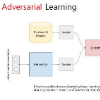GANs promise indistinguishability, logic explains it. We put the two on a budget: a discriminator that can only ``see'' up to a logical depth $k$, and a generator that must look correct to that bounded observer. \textbf{LOGAN} (LOGical GANs) casts the discriminator as a depth-$k$ Ehrenfeucht--Fra\"iss\'e (EF) \emph{Opponent} that searches for small, legible faults (odd cycles, nonplanar crossings, directed bridges), while the generator plays \emph{Builder}, producing samples that admit a $k$-round matching to a target theory $T$. We ship a minimal toolkit -- an EF-probe simulator and MSO-style graph checkers -- and four experiments including real neural GAN training with PyTorch. Beyond verification, we score samples with a \emph{logical loss} that mixes budgeted EF round-resilience with cheap certificate terms, enabling a practical curriculum on depth. Framework validation demonstrates $92\%$--$98\%$ property satisfaction via simulation (Exp.~3), while real neural GAN training achieves $5\%$--$14\%$ improvements on challenging properties and $98\%$ satisfaction on connectivity (matching simulation) through adversarial learning (Exp.~4). LOGAN is a compact, reproducible path toward logic-bounded generation with interpretable failures, proven effectiveness (both simulated and real training), and dials for control.
翻译:暂无翻译



